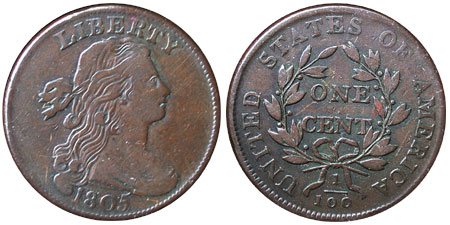Guide to U.S. Draped Bust Cents
The Draped Bust Large Cent was introduced in 1796 and struck continuously until 1807. This represented the fourth design for the denomination and featured a portrait of Liberty with a slightly more mature appearance than earlier renditions. A similar portrait had also been introduced on the silver denominations the same year, following its appearance on a limited number of silver dollars in 1795. This can be perhaps be considered the first successful usage of similar designs across various denominations within American coinage.

The Draped Bust Cent was designed by Robert Scot. He had started as an assistant engraver in the early 1790’s, working on the majority of the dies for the Liberty Cap Cent, which had been designed by Joseph Wright. This would no doubt prove to be valuable experience when new designs were requested for circulating coinage in the mid 1790’s. Scot is believed to have based his rendition of Liberty on a painting of Ann Willing Bingham by Gilbert Stuart.
On the obverse of the new design, Liberty is pictured facing to the right. As the series name implies, her bust is draped, while her hair is lightly bound by a ribbon. Miss Liberty has a slightly older appearance, which is somewhat surprising, as Bingham was not even 30 at the time Stuart painted her. Perhaps the older appearance created by Scot was intentional, although the true reason appears to have been lost to history. Like the earlier design of the cent, the only other features on the obverse are the inscriptions of LIBERTY above and the date below.
The reverse is nearly identical to the design from the previous type. A simple wreath is shown surrounding the denomination expressed as ONE CENT. The denomination is additionally expressed as 1/100 for the many Americans of the time period who could not read. The inscription UNITED STATES OF AMERICA is around, placed close to the rim.
Like all early American coins, most of the lettering was punched by hand onto the working dies, resulting in different placement of the lettering relative to the devices present on the hub or master die. This created many varieties, which are heavily collected for the early large cents. The Draped Bust Large Cent series has always been intensely studied and remains one of the most popular series to be collected by variety.

